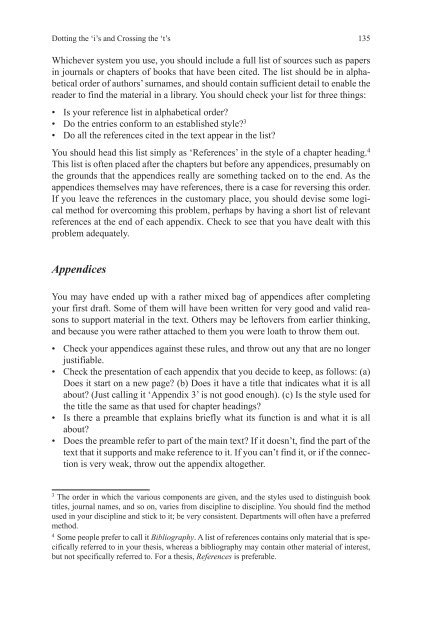How-to-Write-a-Better-Thesis
Create successful ePaper yourself
Turn your PDF publications into a flip-book with our unique Google optimized e-Paper software.
Dotting the ‘i’s and Crossing the ‘t’s<br />
135<br />
Whichever system you use, you should include a full list of sources such as papers<br />
in journals or chapters of books that have been cited. The list should be in alphabetical<br />
order of authors’ surnames, and should contain sufficient detail <strong>to</strong> enable the<br />
reader <strong>to</strong> find the material in a library. You should check your list for three things:<br />
• Is your reference list in alphabetical order?<br />
• Do the entries conform <strong>to</strong> an established style? 3<br />
• Do all the references cited in the text appear in the list?<br />
You should head this list simply as ‘References’ in the style of a chapter heading. 4<br />
This list is often placed after the chapters but before any appendices, presumably on<br />
the grounds that the appendices really are something tacked on <strong>to</strong> the end. As the<br />
appendices themselves may have references, there is a case for reversing this order.<br />
If you leave the references in the cus<strong>to</strong>mary place, you should devise some logical<br />
method for overcoming this problem, perhaps by having a short list of relevant<br />
references at the end of each appendix. Check <strong>to</strong> see that you have dealt with this<br />
problem adequately.<br />
Appendices<br />
You may have ended up with a rather mixed bag of appendices after completing<br />
your first draft. Some of them will have been written for very good and valid reasons<br />
<strong>to</strong> support material in the text. Others may be lef<strong>to</strong>vers from earlier thinking,<br />
and because you were rather attached <strong>to</strong> them you were loath <strong>to</strong> throw them out.<br />
• Check your appendices against these rules, and throw out any that are no longer<br />
justifiable.<br />
• Check the presentation of each appendix that you decide <strong>to</strong> keep, as follows: (a)<br />
Does it start on a new page? (b) Does it have a title that indicates what it is all<br />
about? (Just calling it ‘Appendix 3’ is not good enough). (c) Is the style used for<br />
the title the same as that used for chapter headings?<br />
• Is there a preamble that explains briefly what its function is and what it is all<br />
about?<br />
• Does the preamble refer <strong>to</strong> part of the main text? If it doesn’t, find the part of the<br />
text that it supports and make reference <strong>to</strong> it. If you can’t find it, or if the connection<br />
is very weak, throw out the appendix al<strong>to</strong>gether.<br />
3<br />
The order in which the various components are given, and the styles used <strong>to</strong> distinguish book<br />
titles, journal names, and so on, varies from discipline <strong>to</strong> discipline. You should find the method<br />
used in your discipline and stick <strong>to</strong> it; be very consistent. Departments will often have a preferred<br />
method.<br />
4<br />
Some people prefer <strong>to</strong> call it Bibliography. A list of references contains only material that is specifically<br />
referred <strong>to</strong> in your thesis, whereas a bibliography may contain other material of interest,<br />
but not specifically referred <strong>to</strong>. For a thesis, References is preferable.














![[Lonely Planet] Sri Lanka](https://img.yumpu.com/59845622/1/169x260/lonely-planet-sri-lanka.jpg?quality=85)


